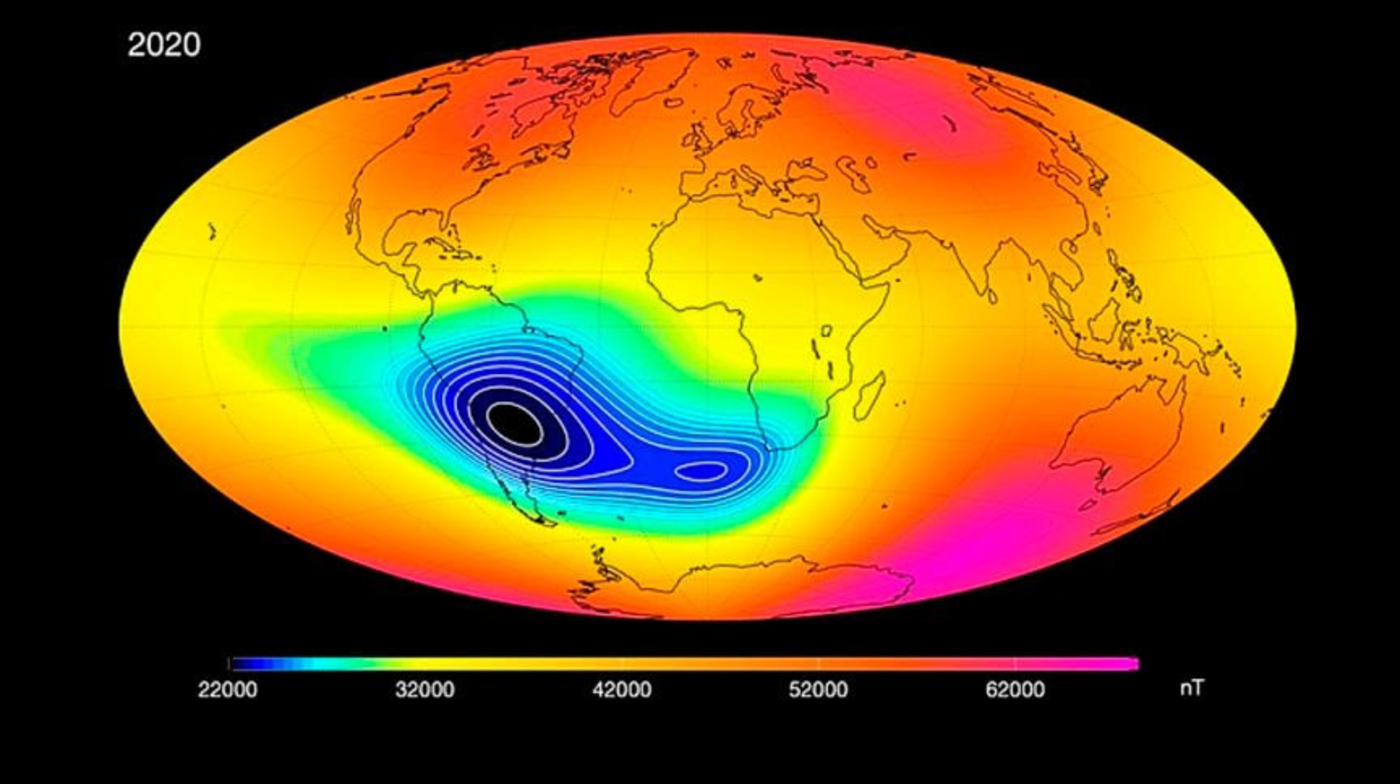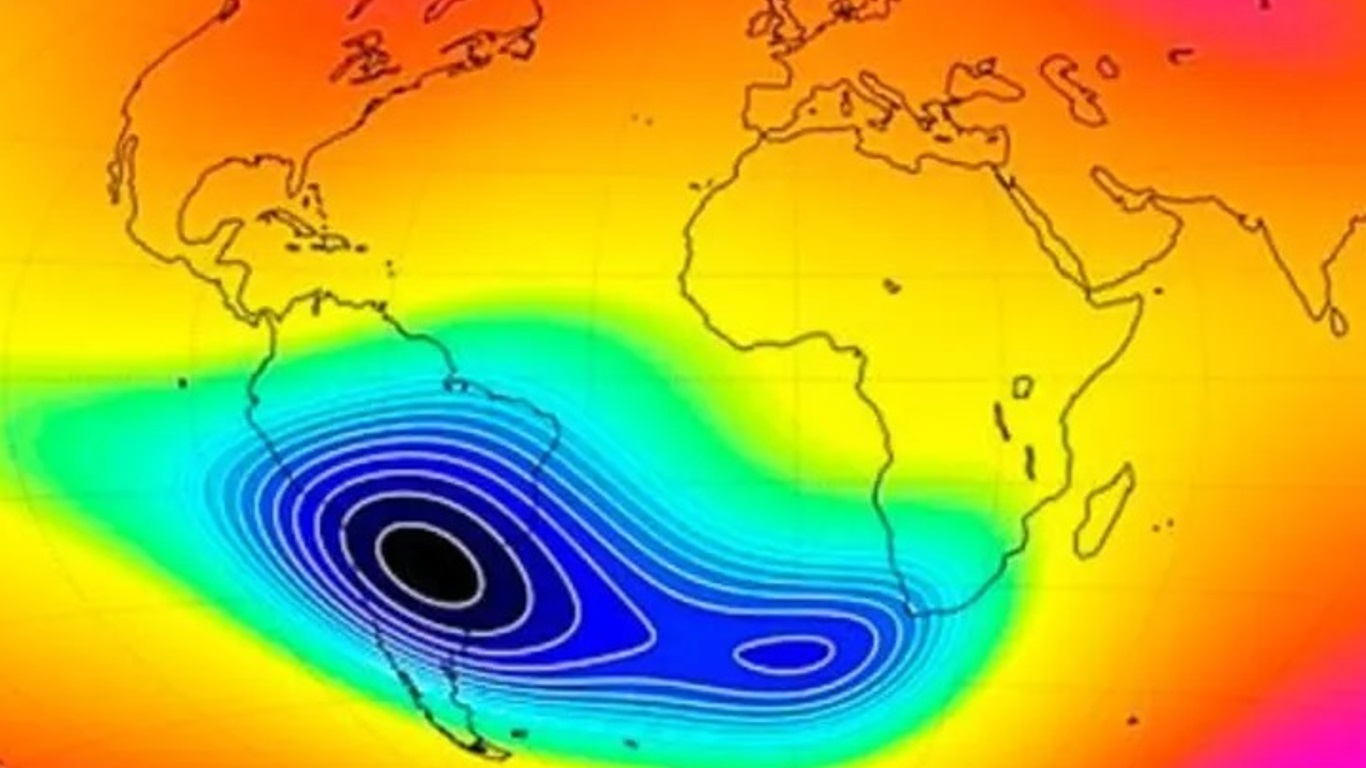
NASA
Scientists are making new discoveries about the so-called South Atlantic Magnetic Anomaly, which affects a large area of South America, including part of Brazil, especially the southern region. Scientific interest in the topic has been growing in recent years, leading to new work on the anomaly in Earth's magnetic field.
A study published in the Proceedings of the National Academy of Sciences shows that the strange behavior of the Earth's magnetic field over the South Atlantic region can be traced back to 11 million years ago, and is unlikely to cause any imminent reversal of the Earth's magnetic field.
The South Atlantic Anomaly is a weak point in the Earth's magnetic field, which protects the planet from high doses of solar wind and cosmic radiation. This anomaly exists because Earth's inner Van Allen radiation belt is moving closer to the planet's surface, causing an increased flow of energetic particles. In turn, this anomaly also causes technical disturbances to satellites and spacecraft orbiting around the Earth.
Researchers at the University of Liverpool in England studied igneous or volcanic rocks on the island of St. Helena, which is located in the South Atlantic Anomaly, and records of the Earth's magnetic field were preserved in the igneous rocks, providing a detailed look at the planet's magnetic history.
“Our study provides the first long-term analysis of the magnetic field in this region dating back millions of years,” Yael Ingebers, the study’s lead author, said in a statement. “This reveals that the magnetic field anomalies in the South Atlantic are not isolated; similar anomalies have been present for 8 to 11 million years.”
The researchers studied rocks from 34 volcanic eruptions that occurred on St. Helena between 8 and 11 million years ago. As volcanic rock cools, the tiny grains of iron oxide inside it become magnetized, maintaining the direction and strength of Earth's magnetic field at that time and location.
The authors explained that the Earth's magnetic field lines extend from south to north. Geomagnetic records from rocks show that the magnetic field on St. Helena was pointing in different directions during previous eruptions. This indicates that the magnetic field in this region was unstable millions of years ago.
The Earth's magnetic field changes strength and direction over time. It is believed that these fluctuations could eventually lead to a reversal of the Earth's magnetic field. However, given that the magnetic field in the South Atlantic Anomaly Zone has been unstable for several million years, it is unlikely to be associated with any imminent reversal, according to the statement.
“It also supports previous studies suggesting a link between the South Atlantic anomaly and anomalous seismic features in the planet's lower mantle and outer core,” Ingebers said in the statement. “This brings us closer to linking the behavior of the Earth's magnetic field directly to the properties of the Earth's interior.”
Another study discounts risks in commercial aviation
The magnetic anomaly in the South Atlantic Ocean causes a significant increase in ionizing radiation levels and related effects on spacecraft in low Earth orbit, as well as a corresponding increase in radiation exposure to astronauts and electronic components on the International Space Station.
According to urban legend, the anomaly was also supposed to be able to affect the radiation field in the atmosphere, reaching civil aviation heights. To identify and quantify any additional contributions to ubiquitous radiation exposure at flight altitudes, comprehensive measurements were made across the geographic region of the anomaly at an altitude of 13 km in a unique flight mission called “Atlantic Kiss”.
According to a study published in the prestigious scientific journal Nature, no indication of increased radiation exposure was found during the research flight, and therefore this anomaly does not expose passengers or crew of commercial flights in Brazil, South America, or the South Atlantic to higher levels of radiation. Radiation. Cosmic radiation rates.
“In fact, this result is not surprising, because there is no sufficiently efficient mechanism to transfer radiation generated by protons with common energies from the inner radiation belt to flying altitudes,” the authors highlight.
“In summary, the results of the Atlantic Kiss mission contribute to debunking the urban myth of generally increased levels of ionizing radiation at flight altitudes in the geographic region of the South Atlantic Anomaly, which caused unnecessary fears among crew members and passengers,” concludes the research.
What is a magnetic anomaly in the South Atlantic Ocean?
Unlike Mercury, Venus, and Mars, Earth is surrounded by a massive magnetic field called the magnetosphere. The magnetosphere, created by strong dynamical forces at the center of our universe, protects us from the erosion of our atmosphere by the solar wind (charged particles constantly being bombarded by our Sun), erosion, and particle radiation from coronal mass ejections (huge clouds of energy). magnetized solar plasma and radiation), and cosmic rays from deep space.
The magnetosphere plays the role of a sentinel, repelling this unwanted energy that is harmful to life on Earth, and keeping most of it at a safe distance from the Earth's surface in double donut-shaped regions called Van Allen belts.
What catches the most attention is the abbreviation AMAS, which stands for Magnetic anomalies in the South Atlantic. This is a phenomenon that is still a mystery to science, and it is not uncommon for someone on social media to wonder whether it is interfering with the climate of Brazil and South America, although there is no evidence at all so far.

Noah
AMAS, which grows and has its center closer to South America, is a type of lag in the magnetic shielding of the Earth located over the South Atlantic Ocean, more specifically in the southern and southeastern regions of Brazil, in a strip extending to Africa.
But how might this lack of armor over the South Atlantic affect life on our planet? One outcome we already understand is the performance of satellites in Earth orbit. When passing through an area with low background protection, they may experience damage caused by cosmic radiation flux.
Therefore, this anomaly is monitored by space agencies such as the European Space Agency, NASA, and more recently by Brazil, which launched the NanosatC-BR2 nanosatellite into space with this mission. This is what Marcel Nogueira, Doctor of Physics, researcher at the National Observatory, explained to the Brazilian News Agency.
Why are space agencies interested in this anomaly? Because since this region has a weaker field, solar wind particles enter this region more easily, and the flow of charged particles passing through that region is much more intense.
“This means that when satellites pass through this area, they sometimes have to remain in standby mode, with some components temporarily turned off to avoid losing the satellite or any equipment that might burn out. Because the radiation, especially electrons, in this area is very strong. Therefore “It is in the interest of space agencies to constantly monitor the development of this anomaly, especially in this central range.”
Imagine a day without the Internet, cell phones, GPS, or communications? If the phenomenon affects the satellites responsible for communications and geographical positioning systems, it could affect our technological lives.
“If we also study storms, we will be able to improve and protect our electrical power distribution system, and avoid power outages. Because in our daily life that we live today, which is very dependent on technology, any kind of power outage in the electrical system, in Any country, generates losses of millions or even billions of dollars. It is something very important for our technological life nowadays,” says the researcher.
In Brazil, in addition to the nanosatellite launched into space in partnership with the Russian Space Agency, there are also two magnetic observatories that focus, among other missions, on answering questions about this anomaly: Vasouras, in Rio de Janeiro, and Tatuca, in the Amazon region. .
Both are part of the global network of Intermagnet magnetic observatories. The lack of conclusions raises curiosity about the anomalies in the South Atlantic. This is why it ends up being popularly associated with events like those that have already been recorded in the Bermuda Triangle. But Marcel prefers to say that the phenomenon represents a much more technological challenge, and that there are no conclusions indicating the dangers of the flow of cosmic radiation to human life.
MetSul Meteorologia is available on WhatsApp channels. subscription here To access the channel in the messaging application and receive forecasts, alerts and information about the most important weather and climate events in Brazil and around the world, with exclusive data and information from our team of meteorologists.

“Wannabe internet buff. Future teen idol. Hardcore zombie guru. Gamer. Avid creator. Entrepreneur. Bacon ninja.”

